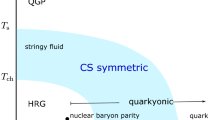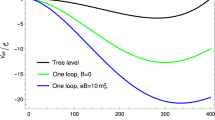Abstract
We investigate the dependence of the chiral condensate \(\langle\bar{q}q\rangle\) on the temperature and quark density using the soft-wall holographic model of QCD, adopting geometries with black holes at finite temperature and quark chemical potential μ. We find that, for μ below a critical value, increasing the temperature the condensate decreases and vanishes at a temperature \(\tilde{T}\simeq210~\mathrm{MeV}\) (at μ=0). An analogous behaviour is observed increasing the chemical potential at fixed temperature. These results agree with the findings obtained by other methods. We also comment on the robustness of the results if geometries not involving black holes are adopted at low temperature, and an Hawking–Page transition is implemented.



Similar content being viewed by others
Notes
An interesting discussion about understanding and foremost issues in QCD can be found in [1].
For a review see [2].
L M and R M are in the singlet representation of SU(N f ) R and SU(N f ) L , respectively.
It has also been proposed to restrict the validity of the model to the IR region, in which case m q should be interpreted as a constituent quark mass [35].
A critical temperature T C ≃210 MeV, associated to the deconfinement transition, has been obtained in a soft-wall model with AdS/BH geometry and no Hawking–Page transition, analyzing the static quark-antiquark pair potential [42].
The factor here is different from the one found in [27] due to a different definition of the scalar field X 0.
References
M. Shifman, Int. J. Mod. Phys. A 25, 4015 (2010)
P. Braun-Munzinger, J. Wambach, Rev. Mod. Phys. 81, 1031 (2009)
Y. Aoki, G. Endrodi, Z. Fodor, S.D. Katz, K.K. Szabo, Nature 443, 675 (2006)
A. Bazavov, T. Bhattacharya, M. Cheng, N.H. Christ, C. DeTar, S. Ejiri, S. Gottlieb, R. Gupta et al., Phys. Rev. D 80, 014504 (2009)
A. Bazavov, T. Bhattacharya, M. Cheng, C. DeTar, H.T. Ding, S. Gottlieb, R. Gupta, P. Hegde et al., arXiv:1111.1710 [hep-lat] and in references therein
Z. Fodor, S.D. Katz, Phys. Lett. B 534, 87 (2002)
M. D’Elia, M.-P. Lombardo, Phys. Rev. D 67, 014505 (2003)
G. Endrodi, Z. Fodor, S.D. Katz, K.K. Szabo, J. High Energy Phys. 1104, 001 (2011)
O. Philipsen, arXiv:1111.5370 [hep-ph]
P. Gerber, H. Leutwyler, Nucl. Phys. B 321, 387 (1989)
V. Koch, nucl-th/9512029
M. Buballa, Phys. Rep. 407, 205 (2005)
D. Muller, M. Buballa, J. Wambach, Phys. Rev. D 81, 094022 (2010)
J.M. Maldacena, Adv. Theor. Math. Phys. 2, 231 (1998). [Int. J. Theor. Phys. 38, 1113 (1999)]
S.S. Gubser, I.R. Klebanov, A.M. Polyakov, Phys. Lett. B 428, 105 (1998)
E. Witten, Adv. Theor. Math. Phys. 2, 253 (1998)
A. Karch, E. Katz, D.T. Son, M.A. Stephanov, Phys. Rev. D 74, 015005 (2006)
O. Andreev, Phys. Rev. D 73, 107901 (2006)
S. Kobayashi, D. Mateos, S. Matsuura, R.C. Myers, R.M. Thomson, J. High Energy Phys. 0702, 016 (2007)
I. Iatrakis, E. Kiritsis, A. Paredes, J. High Energy Phys. 1011, 123 (2010)
P. Colangelo, F. De Fazio, F. Giannuzzi, F. Jugeau, S. Nicotri, Phys. Rev. D 78, 055009 (2008)
J. Erlich, E. Katz, D.T. Son, M.A. Stephanov, Phys. Rev. Lett. 95, 261602 (2005)
O. Andreev, V.I. Zakharov, Phys. Rev. D 74, 025023 (2006)
L. Da Rold, A. Pomarol, Nucl. Phys. B 721, 79 (2005)
D.T. Son, M.A. Stephanov, Phys. Rev. D 69, 065020 (2004)
J. Hirn, V. Sanz, J. High Energy Phys. 0512, 030 (2005)
P. Colangelo, F. De Fazio, J.J. Sanz-Cillero, F. Giannuzzi, S. Nicotri, Phys. Rev. D 85, 035013 (2012)
S.K. Domokos, J.A. Harvey, A.B. Royston, J. High Energy Phys. 1105, 107 (2011)
R. Alvares, C. Hoyos, A. Karch, Phys. Rev. D 84, 095020 (2011)
I.R. Klebanov, E. Witten, Nucl. Phys. B 556, 89 (1999)
A. Cherman, T.D. Cohen, E.S. Werbos, Phys. Rev. C 79, 045203 (2009)
K. Ghoroku, M. Yahiro, Phys. Rev. D 73, 125010 (2006)
Y. Kim, B.-H. Lee, S. Nam, C. Park, S.-J. Sin, Phys. Rev. D 76, 086003 (2007)
T. Gherghetta, J.I. Kapusta, T.M. Kelley, Phys. Rev. D 79, 076003 (2009)
S.S. Afonin, Phys. Rev. C 83, 048202 (2011)
C.A. Dominguez, M. Loewe, J.C. Rojas, J. High Energy Phys. 0708, 040 (2007)
M. Blank, A. Krassnigg, Phys. Rev. D 82, 034006 (2010)
A.M. Halasz, A.D. Jackson, R.E. Shrock, M.A. Stephanov, J.J.M. Verbaarschot, Phys. Rev. D 58, 096007 (1998)
D. Huang, Y.-L. Wu, arXiv:1110.4491 [hep-ph]
S. Borsanyi et al. (Wuppertal–Budapest Collaboration), J. High Energy Phys. 1009, 073 (2010)
C.P. Herzog, Phys. Rev. Lett. 98, 091601 (2007)
O. Andreev, V.I. Zakharov, Phys. Lett. B 645, 437 (2007)
M. Fujita, K. Fukushima, T. Misumi, M. Murata, Phys. Rev. D 80, 035001 (2009)
P. Colangelo, F. Giannuzzi, S. Nicotri, Phys. Rev. D 80, 094019 (2009)
P. Colangelo, F. Giannuzzi, S. Nicotri, J. High Energy Phys. 1205, 076 (2012)
M. Fujita, T. Kikuchi, K. Fukushima, T. Misumi, M. Murata, Phys. Rev. D 81, 065024 (2010)
P. Colangelo, F. Giannuzzi, S. Nicotri, Phys. Rev. D 83, 035015 (2011)
K. Jo, B.-H. Lee, C. Park, S.-J. Sin, J. High Energy Phys. 1006, 022 (2010)
B.-H. Lee, C. Park, S.-J. Sin, J. High Energy Phys. 0907, 087 (2009)
A. Barducci, R. Casalbuoni, G. Pettini, R. Gatto, Phys. Rev. D 49, 426 (1994)
S.-J. Sin, J. High Energy Phys. 0710, 078 (2007)
Acknowledgements
We thank F. De Fazio and F. Jugeau for helpful discussions and collaboration in the early stage of this work. This work is supported in part by the Italian MIUR PRIN 2009.
Author information
Authors and Affiliations
Corresponding author
Appendix
Appendix
A proportionality between the coefficient σ(T) and the chiral condensate is found here, showing that all the temperature dependence of \(\langle\bar{q} q\rangle\) is contained in σ(T), while the coefficient of proportionality is temperature-independent and ensures a correct scaling of quantities with the number of colours. The chiral condensate can be computed within holographic approaches through the relation

being \(\langle J_{S}^{0} \rangle\) the vacuum expectation value of the quark scalar current. In order to evaluate this quantity, let us consider the on-shell action for the scalar field

where

X 0(z) is the expectation value we have considered in this paper, π is the chiral field, and S(x,z) is the fluctuation describing scalar mesons [21]:

S(x−y,z) being the bulk-to-boundary propagator and \(S_{0}^{a}\) the source, according to the holographic dictionary [16]; T a (a=1,…,8) are the Gell-Mann matrices and \(T^{0}=\mathbf{1}/\sqrt{2n_{f}}\). Then in the holographic model the following relation holds:

and, in the Fourier space, defining

the vev of the scalar current reads

where the prime indicates a derivative with respect to z. At finite temperature and for low values of the fifth coordinate z, the scalar field \(\tilde{S}(q,z)\) can be written as

where we have used the boundary condition \(\tilde{S}(q,z)/ z \stackrel{z\to0}{\rightarrow} 1\), and A(T) and B(T) are coefficients we do not need to specify for the scope of the calculation. The low-z behaviour of X 0 is

where only σ(T) depends on the temperature, as shown in the paper. Plugging (A.8) and (A.9) into (A.7), we find the proportionality relation between the coefficient σ(T) and the chiral condensateFootnote 8

provided σ(T) is finite in this limit. This result shows that the temperature dependence of the chiral condensate is only governed by σ(T), the proportionality coefficient N c /(4π 2) not depending on T. It is worth stressing that such a coefficient ensures the correct scaling of all the quantities involved in Eq. (A.9) with N c . This solves the problem of the scaling of the vev with N c pointed out in [31], since all the coefficients in the expansion (A.9) scale as \(N_{c}^{0}\), while \(\langle\bar{q}q\rangle\) scales as N c .
Rights and permissions
About this article
Cite this article
Colangelo, P., Giannuzzi, F., Nicotri, S. et al. Temperature and quark density effects on the chiral condensate: an AdS/QCD study. Eur. Phys. J. C 72, 2096 (2012). https://doi.org/10.1140/epjc/s10052-012-2096-9
Received:
Revised:
Published:
DOI: https://doi.org/10.1140/epjc/s10052-012-2096-9




